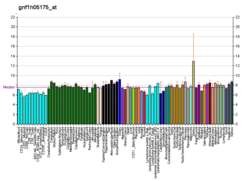Protein-coding gene in the species Homo sapiens
| OR13F1 |
|---|
|
| Identifiers |
|---|
| Aliases | OR13F1, OR9-6, olfactory receptor family 13 subfamily F member 1 |
|---|
| External IDs | MGI: 3030109; HomoloGene: 17418; GeneCards: OR13F1; OMA:OR13F1 - orthologs |
|---|
| Gene location (Human) |
|---|
 | | Chr. | Chromosome 9 (human)[1] |
|---|
| | Band | 9q31.1 | Start | 104,504,263 bp[1] |
|---|
| End | 104,505,222 bp[1] |
|---|
|
| RNA expression pattern |
|---|
| Bgee | |
|---|
| BioGPS | 
 | | More reference expression data |
|
|---|
|
| Gene ontology |
|---|
| Molecular function | - G protein-coupled receptor activity
- olfactory receptor activity
- signal transducer activity
- adrenergic receptor activity
- dopamine neurotransmitter receptor activity, coupled via Gi/Go
- dopamine binding
| | Cellular component | - integral component of membrane
- plasma membrane
- integral component of plasma membrane
- membrane
- synaptic vesicle membrane
- intracellular anatomical structure
| | Biological process | - adenylate cyclase-activating adrenergic receptor signaling pathway
- sensory perception of smell
- detection of chemical stimulus involved in sensory perception of smell
- signal transduction
- response to stimulus
- synaptic transmission, dopaminergic
- negative regulation of adenylate cyclase activity
- adenylate cyclase-inhibiting dopamine receptor signaling pathway
- response to toxic substance
- regulation of dopamine secretion
- regulation of potassium ion transport
- behavioral response to cocaine
- behavioral response to ethanol
- negative regulation of cytosolic calcium ion concentration
- negative regulation of synaptic transmission, glutamatergic
- phospholipase C-activating dopamine receptor signaling pathway
- negative regulation of voltage-gated calcium channel activity
- G protein-coupled receptor signaling pathway
- adrenergic receptor signaling pathway
- adenylate cyclase-modulating G protein-coupled receptor signaling pathway
| | Sources:Amigo / QuickGO |
|
| Orthologs |
|---|
| Species | Human | Mouse |
|---|
| Entrez | | |
|---|
| Ensembl | | |
|---|
| UniProt | | |
|---|
| RefSeq (mRNA) | | |
|---|
| RefSeq (protein) | | |
|---|
| Location (UCSC) | Chr 9: 104.5 – 104.51 Mb | n/a |
|---|
| PubMed search | [2] | [3] |
|---|
|
| Wikidata |
| View/Edit Human | View/Edit Mouse |
|
Olfactory receptor 13F1 is a protein that in humans is encoded by the OR13F1 gene.[4]
Olfactory receptors interact with odorant molecules in the nose, to initiate a neuronal response that triggers the perception of a smell. The olfactory receptor proteins are members of a large family of G-protein-coupled receptors (GPCR) arising from single coding-exon genes. Olfactory receptors share a 7-transmembrane domain structure with many neurotransmitter and hormone receptors and are responsible for the recognition and G protein-mediated transduction of odorant signals. The olfactory receptor gene family is the largest in the genome. The nomenclature assigned to the olfactory receptor genes and proteins for this organism is independent of other organisms.[4]
See also
References
- ^ a b c GRCh38: Ensembl release 89: ENSG00000186881 – Ensembl, May 2017
- ^ "Human PubMed Reference:". National Center for Biotechnology Information, U.S. National Library of Medicine.
- ^ "Mouse PubMed Reference:". National Center for Biotechnology Information, U.S. National Library of Medicine.
- ^ a b "Entrez Gene: OR13F1 olfactory receptor, family 13, subfamily F, member 1".
Further reading
- Malnic B, Godfrey PA, Buck LB (2004). "The human olfactory receptor gene family". Proc. Natl. Acad. Sci. U.S.A. 101 (8): 2584–9. Bibcode:2004PNAS..101.2584M. doi:10.1073/pnas.0307882100. PMC 356993. PMID 14983052.
- Humphray SJ, Oliver K, Hunt AR, et al. (2004). "DNA sequence and analysis of human chromosome 9". Nature. 429 (6990): 369–74. Bibcode:2004Natur.429..369H. doi:10.1038/nature02465. PMC 2734081. PMID 15164053.
External links
This article incorporates text from the United States National Library of Medicine, which is in the public domain.
Class I
(fish-like receptors) | | Family 51 | |
|---|
| Family 52 | |
|---|
| Family 56 | |
|---|
|
|---|
Class II
(tetrapod specific receptors) | | Family 1 | |
|---|
| Family 2 | |
|---|
| Family 3 | |
|---|
| Family 4 | |
|---|
| Family 5 | |
|---|
| Family 6 | |
|---|
| Family 7 | |
|---|
| Family 8 | |
|---|
| Family 9 | |
|---|
| Family 10 | |
|---|
| Family 11 | |
|---|
| Family 12 | |
|---|
| Family 13 | |
|---|
|
|---|

















